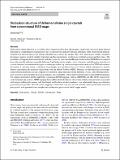Notice
This is not the latest version of this item. The latest version can be found at:https://dspace.mit.edu/handle/1721.1/136757.2
Dislocation structure of deformed olivine single crystals from conventional EBSD maps
| dc.contributor.author | Faul, Ulrich | |
| dc.date.accessioned | 2021-10-29T18:57:13Z | |
| dc.date.available | 2021-10-29T18:57:13Z | |
| dc.date.issued | 2021-09-06 | |
| dc.identifier.uri | https://hdl.handle.net/1721.1/136757 | |
| dc.description.abstract | Abstract Dislocations, linear defects in a crystalline lattice characterized by their slip systems, can provide a record of grain internal deformation. Comprehensive examination of this record has been limited by intrinsic limitations of the observational methods. Transmission electron microscopy reveals individual dislocations, but images only a few square $$\upmu$$ μ m of sample. Oxidative decoration requires involved sample preparation and has uncertainties in detection of all dislocations and their types. The possibility of mapping dislocation density and slip systems by conventional (Hough-transform based) EBSD is investigated here with naturally and experimentally deformed San Carlos olivine single crystals. Geometry and dislocation structures of crystals deformed in orientations designed to activate particular slip systems were previously analyzed by TEM and oxidative decoration. A curvature tensor is calculated from changes in orientation of the crystal lattice, which is inverted to calculate density of geometrically necessary dislocations with the Matlab Toolbox MTEX. Densities of individual dislocation types along with misorientation axes are compared to orientation change measured on the deformed crystals. After filtering (denoising), noise floor and calculated dislocation densities are comparable to those reported from high resolution EBSD mapping. For samples deformed in [110]c and [011]c orientations EBSD mapping confirms [100](010) and [001](010), respectively, as the dominant slip systems. EBSD mapping thus enables relatively efficient observation of dislocation structures associated with intracrystalline deformation, both distributed, and localized at sub-boundaries, over substantially larger areas than has previously been possible. This will enable mapping of dislocation structures in both naturally and experimentally deformed polycrystals, with potentially new insights into deformation processes in Earth’s upper mantle. | en_US |
| dc.publisher | Springer Berlin Heidelberg | en_US |
| dc.relation.isversionof | https://doi.org/10.1007/s00269-021-01157-3 | en_US |
| dc.rights | Creative Commons Attribution | en_US |
| dc.rights.uri | https://creativecommons.org/licenses/by/4.0/ | en_US |
| dc.source | Springer Berlin Heidelberg | en_US |
| dc.title | Dislocation structure of deformed olivine single crystals from conventional EBSD maps | en_US |
| dc.type | Article | en_US |
| dc.identifier.citation | Physics and Chemistry of Minerals. 2021 Sep 06;48(9):35 | en_US |
| dc.identifier.mitlicense | PUBLISHER_CC | |
| dc.eprint.version | Final published version | en_US |
| dc.type.uri | http://purl.org/eprint/type/JournalArticle | en_US |
| eprint.status | http://purl.org/eprint/status/PeerReviewed | en_US |
| dc.date.updated | 2021-09-12T03:08:18Z | |
| dc.language.rfc3066 | en | |
| dc.rights.holder | The Author(s) | |
| dspace.embargo.terms | N | |
| dspace.date.submission | 2021-09-12T03:08:17Z | |
| mit.license | PUBLISHER_CC | |
| mit.metadata.status | Authority Work and Publication Information Needed | en_US |
| mit.metadata.status | Authority Work and Publication Information Needed |
